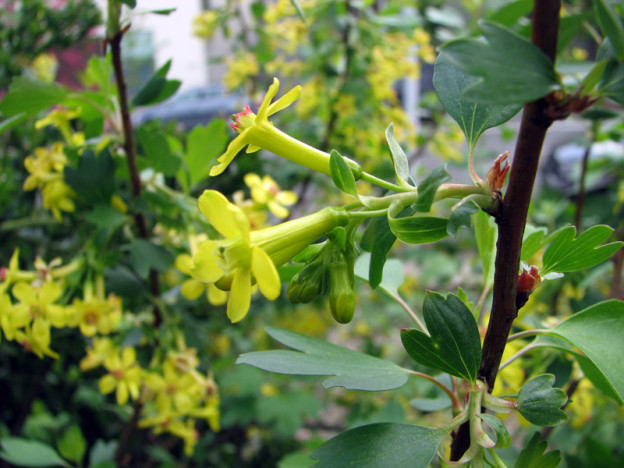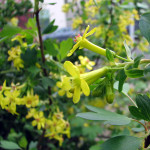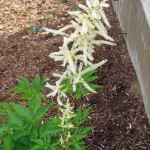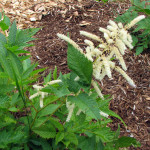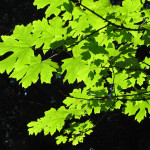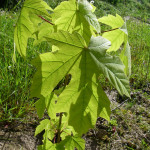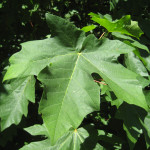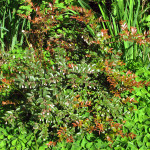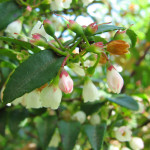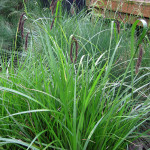Ribes aureum
Golden currant (Ribes aureum) is a small to medium-sized deciduous shrub named for its golden flowers and golden red fall foliage. It is common in Oregon and Washington east of the Cascades and into the Great Basin.
Golden currant grows in full sun and partial shade, in dry to moist conditions, and is drought tolerant. The leaves are deciduous, lobed, and vaguely maple-like, ½ – 1½ inches. Charming clusters of yellow flowers bloom from mid- to late-spring. Golden currant grows to approximately 6 feet tall by 6 feet wide.
It attracts hummingbirds and butterflies such as the spring azure and mourning cloak, and the fruit is eaten by birds and other wildlife. Combine this in a sunny spot with its cousin, red-flowering currant, and drought-tolerant groundcovers like alliums and camas, for a beautiful native display!
- Light Requirements: Full Sun, Part Shade
- Water Requirements: Dry, Moist
- Ease of Growing:
- Growth Rate: Moderate
- Spreads: No
- Wildlife Support: Hummingbirds, Birds or Mammals
- Fire-resistant: No
- Edible: Yes
- Mature Height: 6ft
- Mature Width:6ft
Goat’s Beard

Aruncus dioicus
Goat’s Beard has decorative finely-cut foliage and will create a bold, showy effect for a moist or partly-shaded spot all season. Dense, feathery plumes of tight white flowers rise well above the foliage spring to summer.
Goat’s Beard is an excellent background plant or grouped in a woodland setting. It dies back to the ground in winter, only to return gloriously in the spring. Goat’s Beard spreads slowly by rhizomes to form attractive patches, and can be planted in more sunny areas provided there is good moisture. It’s a “host” plant to the Dusky Azure Butterfly.
- Light Requirements: Part Shade, Full Shade
- Water Requirements: Moist, Perennially Wet
- Ease of Growing: Easy to grow
- Growth Rate: Fast
- Spreads: Yes
- Wildlife Support: Pest-eating Insects, Birds or Mammals, Pollinators
- Fire-resistant: No
- Edible: No
- Mature Height: 5-15ft
- Mature Width:3-5ft
Narrow-leaved Mules Ear

Wyethia angustifolia
Also known as “Narrow-leaved Mule’s Ear” or “California Compassplant”. The inflorescence produces one or more large sunflower-like flower heads at the top of the hairy stem. Large lance-shaped, basal leaves with several smaller, alternate, stem leaves.
- Light Requirements: Full Sun, Part Shade
- Water Requirements: Dry, Moist
- Ease of Growing:
- Growth Rate: Moderate
- Spreads:
- Wildlife Support: Pollinators, Birds or Mammals
- Fire-resistant: No
- Edible:
- Mature Height: 2ft
- Mature Width:1ft
Bigleaf Maple
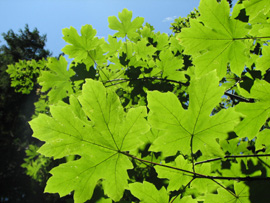
Acer macrophyllum
Acer macrophyllum (Bigleaf or Oregon Maple) is a large deciduous tree with the biggest leaves of any maple. It can grow to nearly 100 feet tall, but more commonly reaches 50-70 feet. It is native to western North America, mostly near the Pacific coast, from southernmost Alaska south to southern California. Some stands are also found inland in the foothills of the Sierra Nevada mountains of central California, and a tiny population occurs in central Idaho.
The palm-shaped leaves are typically 6-12 inches across, with five deeply-incised lobes. The flowers are produced in spring in loose dangling clusters, greenish-yellow with inconspicuous petals. The fruit is a paired, winged, V-shaped samara.
Bigleaf maple is a great wildlife tree. It provides nectar for pollinators, food for the young of tiger swallowtails and mourning cloak butterflies, and shelter for cavity-nesting birds. Mature trees are often covered with moss and ferns which are home to many invertebrates. These miniature ecosystems far above the forest floor capture and filter rain water, and provide food and nest material for birds and small mammals.
Cultivation and Uses
Maple syrup has been made from the sap of bigleaf maple trees. While the sugar concentration is about the same as in sugar maple (Acer saccharum), the flavor is somewhat different. Interest in commercially producing syrup from bigleaf maple sap has been limited.
The lumber from this tree has diverse uses, such as furniture, piano frames and salad bowls. Highly figured wood is not uncommon and is used for veneer and guitar bodies.
- Light Requirements: Full Sun, Part Shade
- Water Requirements: Dry, Moist, Seasonally Wet
- Ease of Growing: Easy to grow
- Growth Rate: Fast
- Spreads: No
- Wildlife Support: Pollinators, Hummingbirds, Pest-eating Insects, Birds or Mammals
- Fire-resistant: Yes
- Edible: Yes
- Mature Height: 90ft
- Mature Width:70ft
Salal

Gaultheria shallon
Salal is a low-growing, leathery-leaved evergreen shrub that tolerates a wide variety of conditions. Its dark blue “berries” (actually swollen sepals) are edible raw and can be made into jams, preserves, and pies. Salal berries are mildly sweet, and are often used in combination with the more tart Oregon grape.
In the Willamette Valley, salal prefers full to partial shade. In coastal areas it can form deep, nearly impenetrable thickets, and easily tolerates full sun. It grows as far north as Baranof Island, Alaska.
Salal leaves are also harvested and sold to florists worldwide for use in floral arrangements.
- Light Requirements: Part Shade, Full Shade
- Water Requirements: Dry, Moist
- Ease of Growing: Easy to grow
- Growth Rate: Moderate
- Spreads: Yes
- Wildlife Support: Pollinators, Hummingbirds, Pest-eating Insects, Birds or Mammals
- Fire-resistant: Yes
- Edible: Yes
- Mature Height: 1-5ft
- Mature Width:1-5ft
Incense Cedar
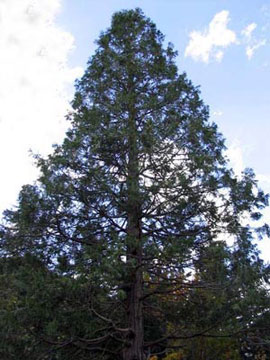
Calocedrus decurrens
Incense cedar is a conifer native from central-western Oregon through most of California. It has a distinct symmetrical shape and can get up to 90 feet tall in its native habitat.
The bark is orange-brown weathering grayish, smooth at first, weathering to grayish, fissured bark that sheds in long strips on the lower trunk on old trees. The fragrant, bright-green foliage is produced in flattened sprays with scale-like leaves. The seed cones look like the open beak of a duck. They turn orange to yellow-brown when mature about 8 months after pollination.
Many birds depend on insects that live on incense cedar, including woodpeckers, brown creepers, red-breasted nuthatches, and golden-crowned kinglets. Birds use the dense foliage for nesting in the summer and shelter in the winter. This tree is also the preferred host of a wood wasp, Syntexis libocedrii, a living fossil species which lays its eggs in the smoldering wood immediately after a forest fire.
Cultivation and Uses
The wood is the primary material for wooden pencils, because it is soft and tends to sharpen easily without forming splinters. It is also a popular ornamental tree, valued for its drought tolerance. In cool summer climates (such as in Washington, British Columbia, etc.), incense cedar tends to grow narrower than in the wild, making it a good choice for large hedges and screens.
- Light Requirements: Full Sun
- Water Requirements: Dry
- Ease of Growing: Easy to grow
- Growth Rate: Slow
- Spreads: No
- Wildlife Support: Birds or Mammals
- Fire-resistant: No
- Edible: No
- Mature Height: 100-150ft
- Mature Width:30ft
Evergreen Huckleberry
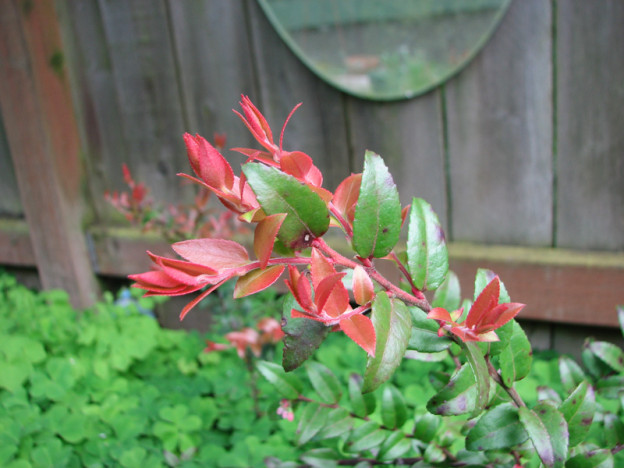
Vaccinium ovatum
Evergreen Huckleberry is a small to medium sized evergreen shrub native to the Pacific Northwest regions of the United States and British Columbia. In the Willamette Valley, it prefers full to partial shade, but will tolerate full sun in coastal areas. It grows slowly and prefers acidic soils.
The shiny, alternately arranged leaves are 2-3.0cm long and 1-1.5cm wide with finely serrated edges. In mid-summer, the plant produces round, edible black berries about 0.5 – 1.0cm in diameter. The berries are a valuable traditional food for many Native American cultures in the Pacific Northwest.
- Light Requirements: Full Sun, Part Shade, Full Shade
- Water Requirements: Moist
- Ease of Growing: Easy to grow
- Growth Rate: Slow
- Spreads: Yes
- Wildlife Support: Pollinators, Hummingbirds, Birds or Mammals
- Fire-resistant: Yes
- Edible: Yes
- Mature Height: 4-8ft
- Mature Width:3-6ft
Slough Sedge

Carex Obnupta
Slough sedge is native to western North America from British Columbia to California where it grows in wetland habitats. The plant produces upright, angled stems approaching 1.2 meters in maximum height, growing in beds or colonies from rhizome networks. The inflorescence is a cluster of flower spikes accompanied by a long leaflike bract.
Wildlife
The lens-shaped seeds are eaten by many kinds of wildlife. Birds known to eat sedge seeds include coots, ducks, marsh birds, shorebirds, upland game birds, and songbirds. In addition to providing food for many wildlife species, sedges are also valuable for cover. Frequently they provide nesting cover for ducks, and their tufted growth furnishes concealment and bedding for other animals. Beavers, otters, muskrats and minks make their way through the sedges as they go to and from the water.
Ethnobotanic
The leaves of slough sedge are used for both wrapping and twining in the grass baskets that are well known and widely marketed by Nitinaht and Nootka women even today.
The Nitinaht believed that picking grasses such as slough sedge for baskets and mats causes fog. The fisherman were always getting annoyed with the women who harvested these materials, because they were always making it foggy. It is said that Hesaquiat men shaved with this grass because the edges are so sharp. There is a saying in Hesaquiat which translates as “you’re just like citapt (slough sedge)” – you never change, because slough sedge is always the same and never seems to change in appearance.
Erosion Control
Slough sedge provides erosion control and streambank stabilization. The dense swards of slough sedge provide sediment retention and nutrient uptake, thus contributing to water quality improvement. Emergent wetland plant communities dominated by slough sedge provide the following hydrologic functions: maintaining river or stream meander patterns; providing a broad, shallow plain where streams slow and sediment deposition occurs; stormwater abatement; a mixing zone where brackish and freshwaters meet; and nutrient-rich habitat for aquatic organisms, fish, waterfowl, and predators such as otter, bald eagles, herons, and raccoons to feed.
- Light Requirements: Full Sun, Part sun
- Water Requirements: Perennially Wet
- Ease of Growing: Easy to grow
- Growth Rate: Moderate
- Spreads:
- Wildlife Support: Birds or Mammals
- Fire-resistant: No
- Edible: No
- Mature Height: 2ft
- Mature Width:1ft

